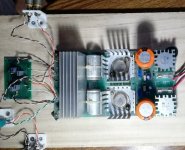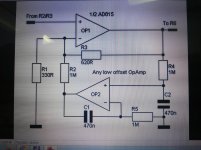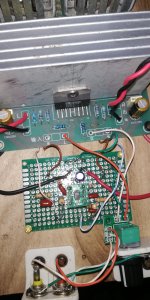I have a constant dc offset of 40mv at the output of this pre. The op amp is TL 072. Tried several other jfet and bipolar op amp but dc offset remains the same
What's the problem ?
What's the problem ?
Attachments
I would check the voltage at the output of the TL072 to see it hasn't saturated. My first guess is there might be not enough adjustment range for the servo to correct the output with 1Mohm output resistor.
With 15V supplies you might get 13uA maximum which corresponds to 8mV at the AD815's output.
With 15V supplies you might get 13uA maximum which corresponds to 8mV at the AD815's output.
Richard
I use +/- 15 v for both AD 815 and TL 072.
I will lower the value of R2 and report back.
Thank you
I use +/- 15 v for both AD 815 and TL 072.
I will lower the value of R2 and report back.
Thank you
I'd suggest 100k for R2, it will give 80mV adjustment range.
The AD815 has a typical input bias current (at the non-inverting input) of 2uA (5uA max). If you go for a 47k input resistor that bias current gives almost 100mV offset at the input, assuming AC coupling of the source. Multiplied by the gain you have (roughly X4) that's almost 400mV at the output. This tends to suggest your input R can't be much higher than 10k which is rather a low value for a preamp input resistance. Or alternatively you need a lower than 100k for R2.
The AD815 has a typical input bias current (at the non-inverting input) of 2uA (5uA max). If you go for a 47k input resistor that bias current gives almost 100mV offset at the input, assuming AC coupling of the source. Multiplied by the gain you have (roughly X4) that's almost 400mV at the output. This tends to suggest your input R can't be much higher than 10k which is rather a low value for a preamp input resistance. Or alternatively you need a lower than 100k for R2.
Last edited:
put a 100k from input to gnd to accomodate the bias current.
Then check the offset without R2, it should not be more than 12mV. If it is higher the opamp is faulty.
Then check the offset without R2, it should not be more than 12mV. If it is higher the opamp is faulty.
put a 100k from input to gnd to accomodate the bias current.
With the typical 2uA bias current that'll give 200mV input offset.
sorry I thought both were tl72, why do you use this line driver, it has more distortion and noise than a good audio opamp.
With the high bias current only low input resistors can be used
With the high bias current only low input resistors can be used
As we're doing DIY here it would be possible to measure the input offset and arrange a current source of the correct polarity to compensate for the bias current. Then a 100k input resistor would be practical - the input impedance is stated as 7M.
....I will lower the value of R2 and report back.
...check the voltage at the output of the TL072 to see it hasn't saturated.....
l change r R2 to 100k. Now l measure 4 mv . dc at the input of AD 815.
Richard, is 4mv acceptable for the TDA amp from you ?
Bansuri, l am still at the testing stage . It sounds pretty decent with TL 72 as dc servo op amp. What would you recommend , avoiding the expensive ?
Actually, l just like to build things as a hobby. many of my amp do not need pre from an engineering point of view .
Richard, is 4mv acceptable for the TDA amp from you ?
Bansuri, l am still at the testing stage . It sounds pretty decent with TL 72 as dc servo op amp. What would you recommend , avoiding the expensive ?
Actually, l just like to build things as a hobby. many of my amp do not need pre from an engineering point of view .
Sorry, The corrected first sentence should read as follows
l change R2 to 100k. Now l measure 4 mv dc at the output of AD 815.
l change R2 to 100k. Now l measure 4 mv dc at the output of AD 815.
Richard, is 4mv acceptable for the TDA amp from you ?
4mV is probably too much DC for the transformer on my monoAMP yes. But have a listen, see if you notice any change with and without a series cap.
I use ADA4177-2 for DC.servos, but SO8 only. Not tooo expensive, RRout gives you more range and you can maybe use R2 100k.
I whipped up a quick simulation, and using the following component values:
R1 = 330Ω
R2 = 15kΩ
R3 = 620Ω
R4 = R5 = 50kΩ
C1 = C2 = 100nF
OP1 = AD815
OP2 = ADA4522-1
...you get an overall circuit offset of 5.34µV, 3dB down points of 1.3Hz and 74MHz, and a 1kHz gain of 9.3dB. The ADA4522-1 is a fantastic servo amp - it's cleaner than a TL07x and it actually has low offset voltage, on the order of single digit microvolts, not millivolts. Because it is a chopper amp, it also has no LF popcorn noise, unlike a BiFET. The drawback is that it is not as cheap as a TL072, but it's not expensive either.
You cannot use it to best effect with high input resistors, since its input bias current is artificially high because of the switching action of the input stage, which will result in substandard offset performance. So, keep the input resistors less than 100kΩ or so and the bias induced additions to offset voltage will be negligible. The 50kΩ used here works well enough.
And, as you can see, you can use 50kΩ or even 66k5Ω with this amp and still get a low corner frequency with a 100nF capacitor. Why is that important? 100nF is the largest 3216 package C0G ceramic cap that you can buy, so you can still assemble a servo with a low corner frequency and low offset using SMD components, making the entire thing extremely small and extremely high performance. The LF point is extended using the output attenuation from the servo, which also attenuates any noise from the servo.
I have built and tested this extensively (using 100nF and 66k5Ω time constant components) with various values of force resistors to match the circuit in question, and it works perfectly. There are no traces of switching noise in the output, and because of the topology and the relative cleanliness of the ADA4522, there is no added distortion or noise whatsoever, measured to below -160dBc.
I'm using the Murata GRM31C5C2A104JA01 100nF 3216 sized capacitor for these servos and it works well. Extremely low distortion, no microphonics, small size, and low cost. This is the 100V rated version, but the GRM31C5C1H104JA01 version, rated for 50V, is indistinguishable. I would argue that these are more reliable and high performance than any film cap since they have no questionable end terminations and no possibility for microphonics.
Another benefit of the ADA4522 is that you can get it in a dual where both amps use the same chopper oscillator, preventing potential "birdies" that could happen with two unsynchronized but "close" choppers that somehow demodulate into each other. If you use twin servos for balanced circuits, the ADA4522-2 is a great choice for that reason.
R1 = 330Ω
R2 = 15kΩ
R3 = 620Ω
R4 = R5 = 50kΩ
C1 = C2 = 100nF
OP1 = AD815
OP2 = ADA4522-1
...you get an overall circuit offset of 5.34µV, 3dB down points of 1.3Hz and 74MHz, and a 1kHz gain of 9.3dB. The ADA4522-1 is a fantastic servo amp - it's cleaner than a TL07x and it actually has low offset voltage, on the order of single digit microvolts, not millivolts. Because it is a chopper amp, it also has no LF popcorn noise, unlike a BiFET. The drawback is that it is not as cheap as a TL072, but it's not expensive either.
You cannot use it to best effect with high input resistors, since its input bias current is artificially high because of the switching action of the input stage, which will result in substandard offset performance. So, keep the input resistors less than 100kΩ or so and the bias induced additions to offset voltage will be negligible. The 50kΩ used here works well enough.
And, as you can see, you can use 50kΩ or even 66k5Ω with this amp and still get a low corner frequency with a 100nF capacitor. Why is that important? 100nF is the largest 3216 package C0G ceramic cap that you can buy, so you can still assemble a servo with a low corner frequency and low offset using SMD components, making the entire thing extremely small and extremely high performance. The LF point is extended using the output attenuation from the servo, which also attenuates any noise from the servo.
I have built and tested this extensively (using 100nF and 66k5Ω time constant components) with various values of force resistors to match the circuit in question, and it works perfectly. There are no traces of switching noise in the output, and because of the topology and the relative cleanliness of the ADA4522, there is no added distortion or noise whatsoever, measured to below -160dBc.
I'm using the Murata GRM31C5C2A104JA01 100nF 3216 sized capacitor for these servos and it works well. Extremely low distortion, no microphonics, small size, and low cost. This is the 100V rated version, but the GRM31C5C1H104JA01 version, rated for 50V, is indistinguishable. I would argue that these are more reliable and high performance than any film cap since they have no questionable end terminations and no possibility for microphonics.
Another benefit of the ADA4522 is that you can get it in a dual where both amps use the same chopper oscillator, preventing potential "birdies" that could happen with two unsynchronized but "close" choppers that somehow demodulate into each other. If you use twin servos for balanced circuits, the ADA4522-2 is a great choice for that reason.
100nF is the largest 3216 package C0G ceramic cap that you can buy, so you can still assemble a servo with a low corner frequency and low offset using SMD components, making the entire thing extremely small and extremely high performance.
https://www.mouser.com/ProductDetail/Murata-Electronics/GRM31C5C1H224JE02L?qs=sGAEpiMZZMvsSlwiRhF8qtsBU8Zhqm2R2h20Tjj%252BsyoT2MOwyf0Xlg%3D%3D
Aaah! Progress! 220nF was not so common 5 years ago when I last shopped for large C0G caps. Turns out, it’s now cheaper than the 100nF part too…
SMD caps just keep getting bigger and bigger, and while they can squish up when the layers get thinner, these are nowhere near that point. Thanks for the pointer!
SMD caps just keep getting bigger and bigger, and while they can squish up when the layers get thinner, these are nowhere near that point. Thanks for the pointer!
you also have to consider that there will be 10-15mV DC on the input, you do not show what is connected there.
Monte.
I am going to order the parts .
Is ADA4522-2ARMZ the same characteristic but 2 amp in the package?
I will use an adapter
thanks
kp93300
I am going to order the parts .
Is ADA4522-2ARMZ the same characteristic but 2 amp in the package?
I will use an adapter
thanks
kp93300
kp93300,
Yes, that is the two channel version, which is the best one to use if you need two servos sharing the same circuit. They also make a quad, but I have not needed that personally.
This is an SO-8 package, which is pretty easy to hand solder onto an adapter board with a little care. No tricky DFN or anything like that.
All the best!
Yes, that is the two channel version, which is the best one to use if you need two servos sharing the same circuit. They also make a quad, but I have not needed that personally.
This is an SO-8 package, which is pretty easy to hand solder onto an adapter board with a little care. No tricky DFN or anything like that.
All the best!
- Home
- Source & Line
- Analog Line Level
- Dc servo circuit for AD815 pre


